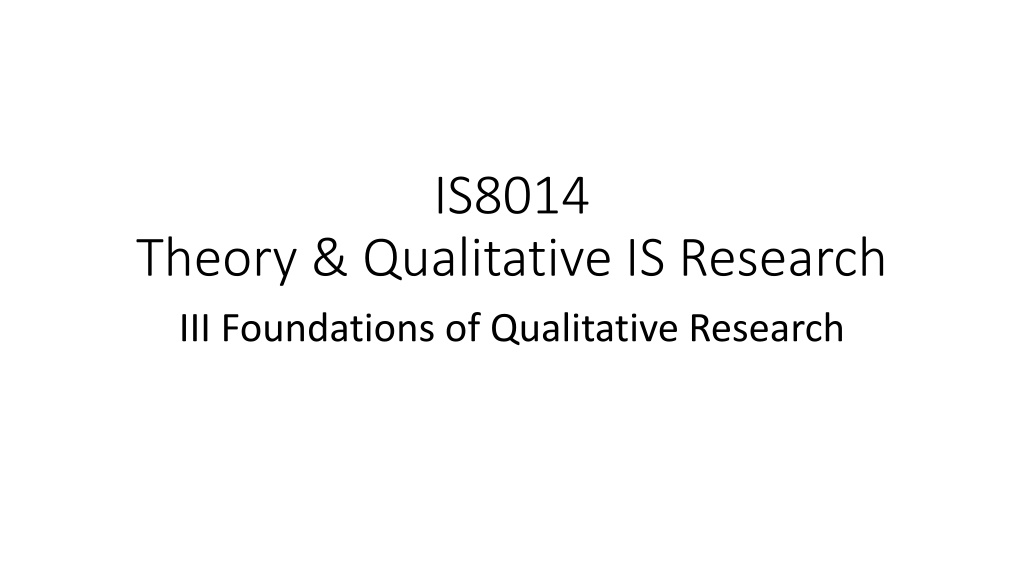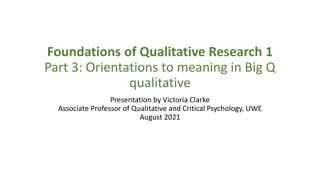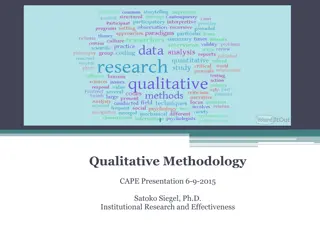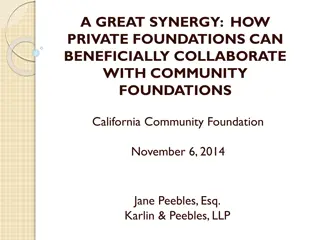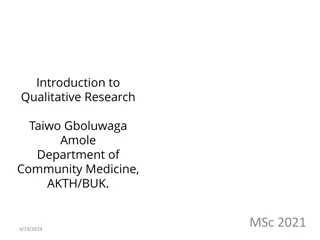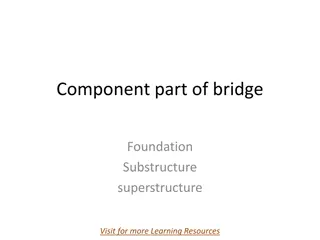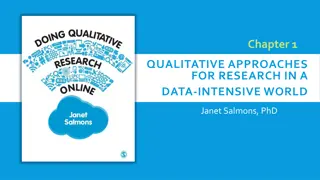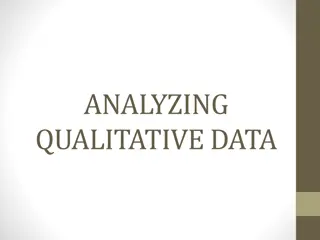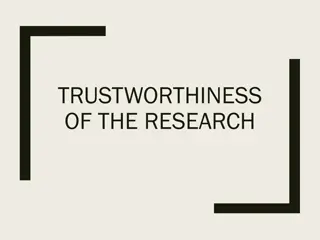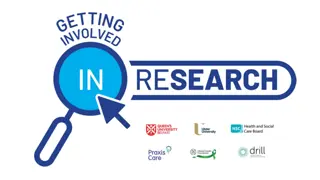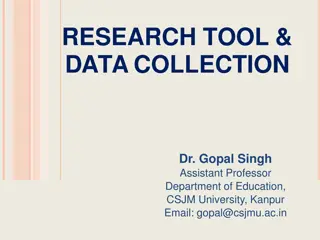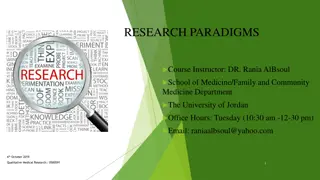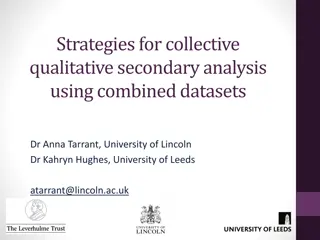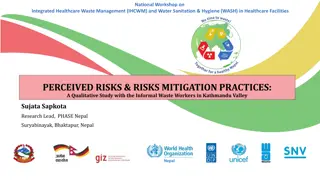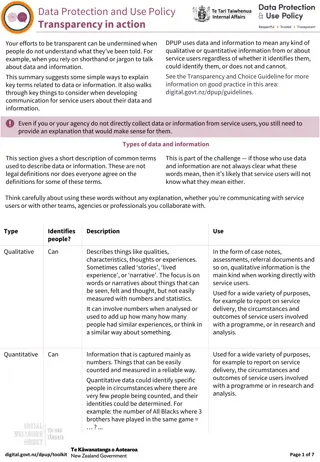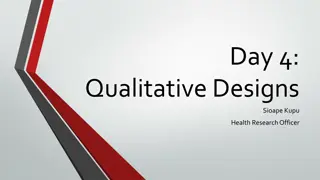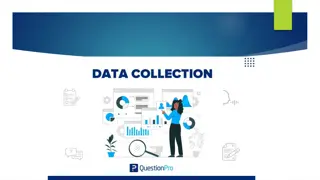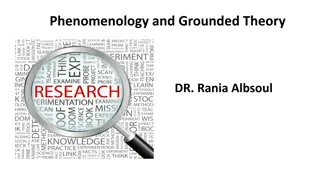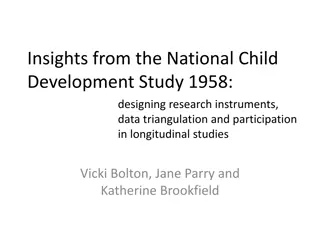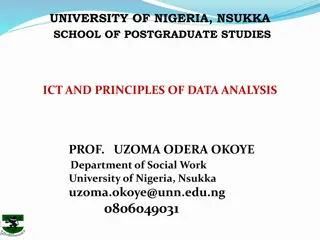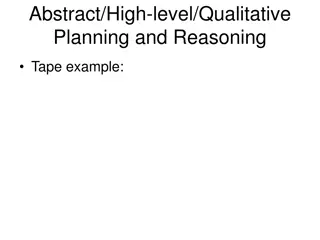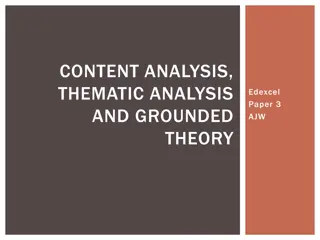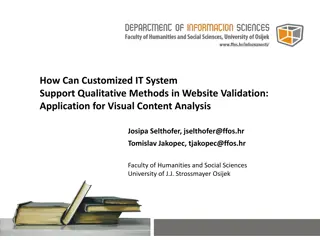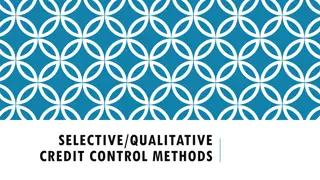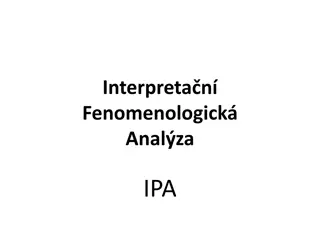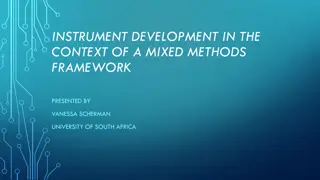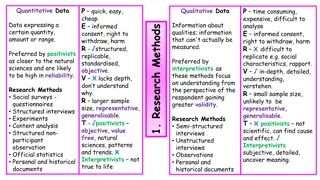Foundations of Qualitative Research: Understanding Methods and Data
Qualitative research involves a mix of different methods drawing on qualitative data, with debates on the need for a sensitive approach for richer appreciation. Understanding qualitative data and context, along with various types of data such as interviews and user-generated content, is essential for effective research. The primary technique of data collection, qualitative interviews, requires careful consideration to avoid common pitfalls.
Download Presentation

Please find below an Image/Link to download the presentation.
The content on the website is provided AS IS for your information and personal use only. It may not be sold, licensed, or shared on other websites without obtaining consent from the author. Download presentation by click this link. If you encounter any issues during the download, it is possible that the publisher has removed the file from their server.
E N D
Presentation Transcript
IS8014 Theory & Qualitative IS Research III Foundations of Qualitative Research
Foundations Qualitative research is not a single method. Indeed, there is much debate about how to do qualitative research Qualitative research refers to a mix of different methods each of which draws on qualitative data Is it enough that any qualitative data is involved? Or do we need a more sensitive approach, and try to ensure that a richer appreciation of a phenomenon is achieved? Or can we require that qualitative researchers adopt either a critical or interpretivist epistemological stance?
Qualitative Data and Context There are many different types of qualitative data, but the decision about which kind of data to collect and analyse depends on the nature of the research question and problem Its useful to review published qualitative research articles so as to explore in more detail what the authors did in terms of Problematisation Research Question Selection of Data and its Analysis Selection of Method How they structured the article as a whole
Types of Qualitative Data Interviews Un/Semi/ Structured; Telephone, IM, Face-to-Face Notes and observations Text, Drawings and Sketches, Audio or Video; Diaries Day to Day; Confessional Documents Usually organisational; Text, Audio or Video; Paper, Web User-generated data Data Subject; Text, Audio or Video Researcher and Data Subject(s) Emails/SMS/IM/Wiki - logs Emails/SMS/IM/Wiki/WeChat/etc. - logs 4
Interviews The interview is the primary technique for data collection that you are likely to encounter Rubin and Rubin (2005) say of qualitative interviews: [permit] us to see that which is not ordinarily on view and examine that which is looked at but seldom seen But many people treat the qualitative interview with little care and assume it is easy to master Few people describe their interview techniques in detail Actually, there are many pitfalls to interviews things to go wrong
Interview Problems You may have permission to interview people but do they want to be interviewed? Perhaps its just a waste of their time! You usually have limited time. You don t really know much about the interviewee(s). There is little time to create trust or guanxi with the interviewee(s) Who selects the interviewees? Is there a bias to let you interview the stars or the elite or reliable people? Language bias and ambiguity what do they really mean? Hawthorne effect: your interview technique may contaminate the interview and the data you collect
Goffmans Dramaturgical Model Goffman (1959, 1961) developed a theory of social interaction which employs the metaphor of the theatre/drama It can be applied to the interview, where the interviewer and interviewee are actors on the stage, and at the same time the audience The interviewer has a script (protocol, questions) Interviewers (and ees) must consider how to dress, how to appear to the other, how to enter and exit the stage The interviewer needs to show empathy for and interest in the interviewee The interviewer controls the process (following the protocol) and guides the interviewee back if s/he strays too far
Interview as Drama (Myers and Newman, 2007) The interviewer decides: What to say and when How to say, encourage, support and deal with silence How to deal with a shy, bored, tired, boastful, proud interviewee How to encourage more detail if the interviewee only says Yes/No How to manage interviewees who try to switch roles How to kick off introduction to yourself, to the questions How to ask but to an incomplete script (don t over prepare) To be open to surprises and serendipitous findings And how to end thanks, who else to interview, follow up, confidence, exit
Interview Protocols A protocol here refers to a plan for the interview Which topics, themes, questions you want to ask How to start? Open and closed questions? Interview or conversation? Free-style or very structured? There are some similarities with surveys. You may not get a second chance to ask, so How will you record the interview? Handwritten notes? iPhone? MP3? It is best to transcribe notes asap, or they get forgotten. How much data? How many interviews? We refer to the concept of data saturation 9
Data Saturation The simple idea is that your data is saturated when interviewing more people will not add a significant amount of new data But different people often talk about the same thing in different ways So it is not just a matter of finding that the same words are being repeated by multiple interviewees Instead, you need to analyse the data, in the cultural context, and see if new meanings are being added with each successive interview In a recent study (Davison et al., 2021) we interviewed 31 people who work in the logistics area of a local HK warehouse (of a global retail firm)
Interview Protocol Example (HK Logistics) I Demographics - D D1 Can you briefly describe your routine duties? D2 What is your position in the company? D3 How long have you been working here? About the system - S S1 Which system do you need to use on a regular basis at work? S2 What is the main purpose of the system (briefly describe the system)? S3 How does this system support your work? S4 Does the organization need this system? Why? S5 How is the system useful for managing the company?
Interview Protocol Example (HK Logistics) II About the difficulties of the system for the employee DS DS1 Do you have any difficulties with using this system? Why? DS2 Which of these difficulties is the one that gives you the most barriers? Why? DS3 Does the system have any deficiencies? Why? DS4 Do you think the system makes the work more difficult for other colleagues? Why? About the difficulties of working DW DW1 Do you have any difficulties in working? Why? DW2 What are the factors that cause these difficulties? Why? DW3 Do you think the difficulties come from human factors or the system s deficiency? Why?
Interview Protocol Example (HK Logistics) III About employees attitude toward this system ATT ATT1 To what extent do you like the system? (Please score out of 10) Why? ATT2 To what extent do you feel that the system provides adequate functionality given the work that needs to be done? About change and workarounds CHG CHG1 In what aspects do you want the system to change (to be improved)? CHG2 If the company can t implement the changes in the near future, will you resist or give up using the current system? Why? CHG3 What workarounds do you think you can use / create? What are the outcomes?
Interview Protocol Example (HK Logistics) IV Social Media - SM SM1 Do you use social media (e.g. WeChat, WhatsApp, etc.) for work purposes? SM2 If so, please describe your usage. SM3 To what extent does social media usage impact (positively or negatively) the way you use the system ? SM4 Do you have any comments about using social media for work? Comments on IT policy CM CM1 Do you think the IT on-job training for employees is enough? If not, in what areas? CM2 Do you think the Information Sharing in the company is enough? If not, in what areas? CM3 Do you think the current IT policy and planning require improvements? Why (and in what areas) or why not?
Notes and Observations In field research, we often encounter interesting situations Conversations with data subjects Watching and reflecting how people behave in different situations Our own internal thoughts and interpretations These unplanned, unscripted events need to be documented carefully, so that we can refer back to them later. It is important to be aware of the data around us and to record them The interesting facts, happenings, people, behaviours A paper notebook is most practical, unless you want to dictate Drawings and sketches as well as text A camera could also be valuable You need to be prepared for the unexpected Some people are not comfortable being recorded, but it is OK to make notes. 15
Diaries Diaries can provide a useful subjective account They are normally written/kept by research subjects, who can be instructed to write down selected behaviours or impressions For instance, if we are investigating data privacy violations, we could ask people in the IT department to document each time they are asked to release private data, together with some details (nature of request, rank of requester, decision taken, etc.) in order to assess actual privacy practices. Confessional diaries are kept by the researcher Very detailed notes about everything that you do on a project Self-reflections, questions, doubts Schultze (2000) 16
Documents Corporate documentation is invaluable, especially in case studies where there is a need to build up a picture of organisational values. Documents may include strategic plans, business processes, standard templates, training manuals, internal telephone books. Documents may be paper or online (web). They may be for internal or external use, for customers, clients, consultants or employees. Documents can include data that you would not think to ask about. So reading them carefully can help you to ask the right questions. 17
User-Generated Data There are many potentially-useful forms of user-generated data Many of them are private and confidential, but it is possible to access them if you ask for permission. In my study of KS practices in Beijing, I was able to access one month s IM data from a power user. We analysed that data and found that 80% was for work purposes (i.e. not just social chatting), esp. for knowledge sharing and coordination work. Some UGD may be contaminated, so select it carefully What other kinds of user-generated data can you think of, and what could we do with them? 18
Data Coding & Sources Organising data so that it can be analysed Looking for thematic patterns in data so as to identify theoretical constructs, as well as practical examples to illustrate existing theory Interview transcripts are a major source of data Corporate documentation is possible User generated texts are a good source, including diaries. There is software for qualitative data coding/analysis, e.g. NVivo. 19
What to Look For? Patterns, themes, frequencies, repetition Can you identify regularities or common features? Are some themes dominant? Does the use of language tell us something? Can we analyse the actual text for hidden or clear meanings? Compare across documents/interviews (intertextuality) 20
Themes Organising data according to patterns or themes that can be identified High-level (Meta) themes Lower-level concepts, patterns The themes may emerge from the data, inductively, or may be identified a priori in the literature, deductively, or emerge from the data and be corroborated by literature, abductively The more consistent data we can get from multiple sources (people) the better we can triangulate our findings 21
The Mechanics of Data Coding Open Coding Read through all the data and look for themes and patterns There is a need for constant comparison of data and themes Selective Coding Focus on developing core categories or major groups of content There needs to be enough evidence for each core category Theoretical Coding Consider how the core categories are related to each other as constructs Develop theoretical propositions that link the constructs together
An Example of Data Coding In the next few slides, I show some examples of the coding that I applied in a recent research project (Davison et al., 2021, that is in the reading list for today s class) I am investigating how employees coordinate the ways in which they work around an enterprise system I focus on two key themes: Coordination Persistence Ultimately, I am interesting in developing theoretical conjectures I follow the data coding guidelines of Gioia et al. (2013)
First Order Concepts I Communicate Workarounds Among Colleagues We communicate the workarounds with other colleagues, so everybody knows that if we face these problems, we can use Excel as a supplementary workaround to support our work. (JA) We communicate within our groups for workarounds. We discuss how can we avoid the mistakes and use Excel to undertake manual work. (IL) Develop Consensus About Workaround Application Workarounds are the result of consensus among all of us. (CH) This workaround has been adopted across several departments because logistics are critical to many different departments. We all agreed that if we have problems, we will use this workaround. (DW)
First Order Concepts II Discuss Workaround Design and Improvement We decide the workaround with our team. When there is a problem, we will have a meeting to discuss how to tackle the problem and minimize the impact. If the workaround provides a good solution we will try to execute it. If the impact is not good, we will see how to improve it. (IY) All super users are doing testing together and we know the problems, so we discuss them together, create workarounds and use them as part of our standard work practice. (PC) Standardise and Document Workarounds After information gathering and sorting in Excel, we can accomplish the arrangement of delivery, the forecasting of the number of delivery vans needed. Those processes are a workaround designed by ourselves. If we employ a new colleague, we have standard operating procedures for workarounds, so even if I leave the company my colleague can accomplish these tasks. (MS) We have a training manual for workarounds that we study individually (TC)
First Order Concepts III Regular Use of Workarounds We do workarounds every day because Navision cannot fit our work process needs (NF) Navision does not provide for the delivery of goods. Therefore we use Excel to manage the delivery process. Without Excel, there is no way to undertake the delivery of goods (MS) Every day we do our work on Excel not in Navision. Excel supports many workarounds because Navision cannot support those functions. We have reported this situation to our superiors for 1.5 years but nothing has changed and so this workaround has become a central component in our regular work process (LT)
Second Order Themes Communicate Workarounds Among Colleagues > Sharing Knowledge About Workarounds Develop Consensus About Workaround Application > Consensus Building Discuss Workaround Design and Development > Co-design Workarounds Standardise and Document Workarounds > Formalise Workarounds Regular Use of Workarounds > Continuous Usage of Workarounds
Aggregate Dimensions Coordination of Workarounds Communicate Workarounds Among Colleagues > Sharing Knowledge About Workarounds Develop Consensus About Workaround Application > Consensus Building Discuss Workaround Design and Development > Co-design Workarounds Persistent Workarounds Standardise and Document Workarounds > Formalise Workarounds Regular Use of Workarounds > Continuous Usage of Workarounds
Translations The literature that we draw on when we theorise is usually published in English The theories, models, constructs, variables, etc. are all explained and justified in English However, our data may or may not be in English It might be written Chinese documents It might be audio-taped Cantonese/Mandarin/xxx conversations The data may need to be translated at some stage But translating ALL the data is a major headache!
Translations Personal Experience A lot of the data that I collect is interview data Some is in Cantonese, some in Mandarin, some in English Transcribing the data from audio to text is very time consuming One hour of audio recording requires one day to transcribe Translating the data requires more time, but much of the data is not very useful So it is better to transcribe first, then to read in the original and select segments for translation Doing this requires a high level of familiarity with the research topics, theory, constructs, etc., and with the kinds of data I am looking for My RA mostly does this kind of work full-time!
If You Analyse Qualitative Data Carefully You may be able to ground a theory out of the data You may see a new way to organise work, people, processes You may identify new constructs that were not previously reported in the literature In the study I mentioned, we identified new forms of behavior not previously mentioned or discussed in the literature Qualitative case studies have been used for theory building, where the case data supports the theory. 32
Methods and Techniques for Qualitative Data Research Case Study Ethnography Action Research Grounded Theory Hermeneutic Interpretation But note that qualitative researchers often combine methods and techniques, e.g. case study + action research; grounded theory + case study
Case Study A case study is an empirical inquiry that: investigates a contemporary phenomenon within its real-life context, especially when the boundaries between phenomenon and context are not clearly evident (Yin, 2003) The case study is the most common research method in IS that draws on qualitative data, though it may also use quantitative data Case study write-ups must include quotations from the data subjects who were studied in order to present a narrative of a situation Case studies can be positivist, interpretivist, or critical. They may draw on both qualitative and quantitative data 34
Ethnography An ethnographer is required to spend a significant amount of time in the field. Ethnographers immerse themselves in the lives of the people they study and seek to place the phenomena studied in their social and cultural context. Ethnographies are used to study the development of systems and work practices/processes. For instance, a study of a community and the way the members of that community use technology to achieve some purpose Cyber-ethnographies do the same thing in online environments such as online communities of practice 35
Action Research Action Research involves the combination of theory and practice through change and reflection in an immediate problematic situation within a mutually acceptable ethical framework (Avison et al. 1999) AR requires researchers to have the dual intention of both improving practice and contributing to theory and knowledge within and beyond the immediate confines of the project AR is an intensive form of research, with extensive time spent with organizational clients in in-depth interactions But there are close to 20 variants of AR, each offering subtle differences in execution and intent 36
Grounded Theory Method is a research method that seeks to develop theory that is grounded in data systematically gathered and analyzed. is "an inductive theory discovery methodology that allows the researcher to develop a theoretical account of the general features of a topic while simultaneously grounding the account in empirical observations or data" (Martin & Turner, 1986) But this is an oversimplification: there are three different variants of GT: Glaserian, Straussian, and Constructivist 37
Hermeneutic Interpretation Hermeneutics is the art of interpretation and so can be applied within the practice of other methods such as case studies and action research It involves making sense of texts What do people mean when they write or say something? Central concepts include: The dialectic between the understanding of the text as a whole and the interpretation of its parts When we attempt to understand a text we always have some prior knowledge or expectation of what the text is about. This prejudices our interpretation. Prejudice itself is rooted in our culture, our education system, our values. As time passes, so a temporal distance opens up between the meaning intended by the author of the text and the meaning today of the reader The reader engages with the text so as to appropriate meaning We will look at an instance of hermeneutic interpretation in a later class
Bdker, M., Gimpel, G. and Hedman, J. (2014) Time-out/Time-in: The Dynamics of Everyday Experiential Computing Devices, Information Systems Journal, 24, 2, 143- 166. Davison, R.M., Wong, L.H.M., Ou, C.X.J. and Alter, S. (2021) The Coordination of Workarounds: Insights from Responses to Misfits between Local Realities and a Mandated Enterprise System, Information & Management 58, 8, 103530, 1-12. How did the authors motivate each paper? Are the papers interesting? Does the motivation make sense to you? How could you have motivated it differently? Was the problematisation effective, and effectively communicated to readers? What was the role of theory in each paper? Does the theory fit the research problem? What are the most difficult aspects of these two papers for you as a reader? Why?
Readings for Next Week LePine, J.A. & King, A.W. (2010) Editors' Comments: Developing Novel Theoretical Insight from Reviews of Existing Theory and Research, Academy of Management Review 35, 4, 506-509. Tarafdar, M., Cooper, C.L. and Stich, J.F. (2019) The Technostress Trifecta: Techno Eustress, Techno Distress and Design: Theoretical directions and an agenda for research, Information Systems Journal 29, 1, 6-42. Webster, J., & Watson, R.T. (2002) Analyzing the Past to Prepare for the Future: Writing a Literature Review. MIS Quarterly 26, 2, xiii-xxiii.
Questions for Next Week What are the primary suggestions of Webster and Watson (2002) for the undertaking of literature reviews? Do they make any suggestions that you disagree with? Why? Evaluate Tarafdar et al. (2019) with reference to the ideas/principles in Webster and Watson 2002).
